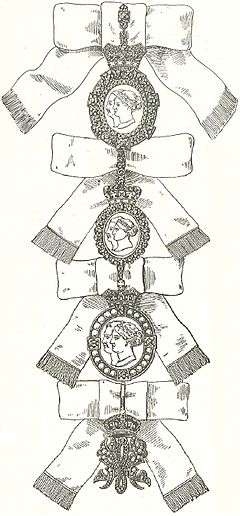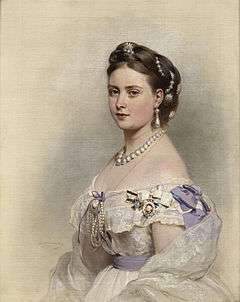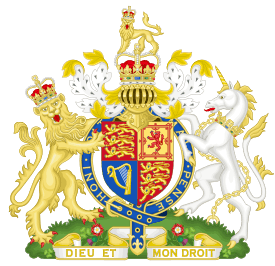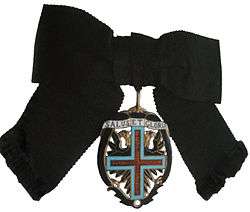Royal Order of Victoria and Albert
The Royal Order of Victoria and Albert was a British Royal Family Order instituted on 10 February 1862[1] by Queen Victoria, and enlarged on 10 October 1864, 15 November 1865, and 15 March 1880. No award was made after the death of Queen Victoria.
| Royal Order of Victoria and Albert | |
|---|---|
 The four grades of the Order | |
| Awarded by the Sovereign, on the advice of Government | |
| Type | Royal Family Order |
| Ribbon | White |
| Eligibility | Female members of the British Royal Family and female courtiers |
| Status | Defunct; not awarded since the death of Queen Victoria, 1901 |
| Post-nominals | VA |
Ribbon of the Order | |


The order had four classes and was only granted to female members of the British Royal Family and female courtiers. For the first three classes, the badge consisted of a medallion of Queen Victoria and Albert, The Prince Consort, differing in the width and jewelling of the border as the classes descend, whilst the fourth substitutes a jewelled cipher. All four were surmounted by a crown, which was attached to a bow of white silk moiré ribbon. The honour conferred no rank or title upon the recipient, but recipients were entitled to use the post-nominal letters "VA".
The last holder of the Order, Princess Alice, Countess of Athlone, died in 1981.
Recipients
First Class
British Royal Family
- The German Empress
- The Grand Duchess of Hesse and by Rhine
- Princess Christian of Schleswig-Holstein
- The Princess of Wales
- The Marchioness of Lorne
- The Princess Beatrice
- The Duchess of Edinburgh
- 1879: The Duchess of Connaught and Strathearn
- The Duchess of Albany
- 1885: Princess Louise of Wales
- Princess Victoria of Wales
- Princess Maud of Wales
- The Duchess of York
- Princess Patricia of Connaught
Foreign
- The Queen of Denmark (Louise)
- The Queen of Hanover (Marie)
- 1878: The Queen of the Belgians (Marie Henriette) (on the occasion of the Silver wedding of the King and Queen)
- Princess Louis of Battenberg (Princess Victoria of Hesse and by Rhine)
- The Queen Regent of Spain (Maria Christina)
- The Grand Duchess of Baden (Louise)
- The German Empress (Augusta Victoria)
- The Queen of Romania (Elisabeta)
- 1896: The Empress of Russia (Alexandra)
- 1898: The Queen of the Netherlands (Wilhelmina)
Second Class
British Royal Family
- Princess Marie of Edinburgh (the Queen's granddaughter, later Queen of Romania)
- Princess Victoria Melita of Edinburgh (the Queen's granddaughter)
- Princess Alexandra of Edinburgh (the Queen's granddaughter)
- Princess Beatrice of Edinburgh (the Queen's granddaughter)
- Princess Margaret of Connaught (the Queen's granddaughter)
- Princess Alice of Albany (the Queen's granddaughter)
Foreign
- Grand Duchess Elizabeth Feodorovna of Russia (the Queen's granddaughter)
- Princess Charlotte, The Hereditary Princess of Saxe-Meinigen (the Queen's granddaughter)
- Princess Irene, Princess Henry of Prussia (the Queen's granddaughter)
- Princess Viktoria, Princess Adolphe of Schaumburg-Lippe (the Queen's granddaughter)
- Princess Marie Amelie, The Duchess of Hamilton, Princess of Baden
- Princess Marie Louise, Princess Aribert of Anhalt (the Queen's granddaughter)
- Princess Sophie, The Crown Princess of Greece (the Queen's granddaughter, later Queen of Greece)
- Princess Margaret, Princess Frederick Charles of Hesse (the Queen's granddaughter)
- Princess Helena Victoria of Schleswig-Holstein (the Queen's granddaughter)
- Princess Victoria Eugenie of Battenberg (the Queen's granddaughter, later Queen of Spain)
Household
- The Countess of Mount Edgcumbe (Lady of the Bedchamber)[2]
- Jane Spencer, Baroness Churchill (Lady of the Bedchamber)[3]
Third Class
- The Duchess of Sutherland
- The Dowager Duchess of Wellington
- Dowager Lady Churchill
- The Dowager Duchess of Roxburghe
- Lady Waterpark
- The Dowager Duchess of Atholl
- Viscountess Clifden
- The Dowager Countess of Mayo
- The Dowager Countess of Erroll
- Lady Abercromby
- Lady Portman
- The Countess of Mount Edgcumbe
- Countess of Gainsborough
- Dowager Lady Southampton
- The Dowager Duchess of Buccleuch
- Viscountess Jocelyn
- 1880: Albertha, Duchess of Marlborough ("in recognition of her unremitting and invaluable exertions in mitigating the misery and distress in Ireland")
- The Dowager Duchess of Bedford
- 1881: The Dowager Duchess of Abercorn
- The Duchess of Roxburghe
- 1885: Countess Spencer
- The Duchess of Buccleuch & Queensberry
- Lady Ampthill
- 1889: The Marchioness of Dufferin and Ava[4]
- Viscountess Downe
- The Countess of Antrim
- 1892: The Marchioness of Salisbury
- The Marchioness of Lansdowne
- The Countess of Lytton
- Frances, Viscountess Chewton
- Countess Cadogan
Fourth Class
- Lady Hamilton-Gordon
- Edith Codrington, Lady Codrington
- Adelaide Biddulph, Baroness Biddulph
- Lady Elizabeth Phillipa Biddulph
- Flora C.I. Macdonald
- Hon Mrs. Ferguson
- Hon Horatia C. F. Stopford
- Hon Emily Sarah Cathcart
- Lady Cust
- Mrs Magdalen Wellesley
- Lady Ponsonby
- Ina Erskine McNeill (Duchess of Argyll)
- 1889: Lady Geraldine Somerset ("as a mark of appreciation of her long and devoted service to the Duchess of Cambridge")
- Harriet Lepel Phipps
- Caroline Fanny Cavendish
- Mrs. Georgina Townshend Wilson
- Lady Cowell
- Hon. Mrs. Mallett
- Hon. Mrs. Grant
- Ethel H. M. Cadogan
- Mrs. John Haughton
Sources
- Whitaker's Almanack, 1893
- British Imperial Calendar, 1900, 1902
- The Times
See also
References
- British Imperial Calendar, 1900
- "Obituary". Obituary. The Times (30343). London. 4 November 1881. col F, p. 16.
- "The Dowager Lady Churchill". Obituaries. The Times (36335). London. 26 December 1900. col E, p. 3.
- "Court Circular". Court and Social. The Times (32607). London. 28 January 1889. col F, p. 9.

